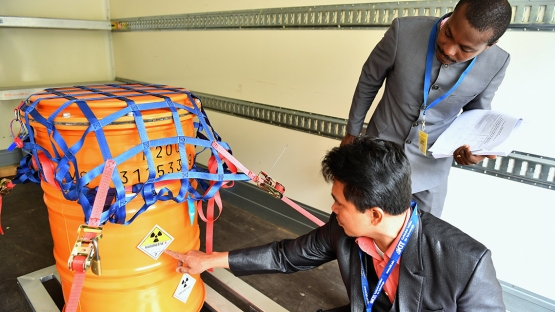Nuclear and other radioactive material is hardest to protect when it is transported from point A to point B — more than half of the incidents of theft of radioactive material reported to the IAEA between 1993 and 2019 occurred while it was in transport.

How to further strengthen nuclear security during transport is one of the topics that will be discussed at the IAEA’s upcoming International Conference on Nuclear Security: Sustaining and Strengthening Efforts (ICONS 2020). The conference will provide a forum for ministers, policymakers, senior officials and experts to discuss current approaches and priorities for nuclear security.
“Secure transport at every step is essential to ensuring society can continue to benefit from these materials, while keeping them out of the hands of terrorists or criminals.”
“There are a lot of moving parts when transporting these materials, which makes them an appealing target for theft or sabotage,” said David Ladsous, Head of the Transport Security Unit at the IAEA. “Secure transport at every step is essential to ensuring society can continue to benefit from these materials, while keeping them out of the hands of terrorists or criminals.”
Around 20 million shipments of nuclear and other radioactive material are regularly transported within countries and across borders each year. These materials are used in industry, agriculture and medicine, as well as in education. Some of them are also radioactive sources that are no longer useful, known as disused sources.
The aim of nuclear security during transport is to ensure that the material is secured throughout and that it is not used for criminal or malicious purposes. While the level of security differs depending on the sensitivity of the material, the fundamental elements of secure transport include physical protection, administrative measures, training and protection of information about the transport routes and schedule. In some cases, escort personnel may also need to be armed.
Some of the major challenges with transport include the fluidity of the situation and the need to continually assess any potential threats and adjust the plans accordingly.
[contextly_sidebar id=”azBwoXgOlLg6xLe4gnEnFVEJM9m7TfpF”]
“At a stationary facility, it is easier to protect a radioactive source, or a disused source, through the facility’s security systems and measures as well as its layers of defense. When it is in transport, there are many more variables, people involved and context changes with every mile travelled. Even an incident as small as a minor traffic collision could freeze the flow of traffic and paralyze the movement of people and goods,” Ladsous said.
To prepare for all possible scenarios, the professionals involved, such as operators, regulators, police, military, and health and environmental agencies, have to use agreed operational procedures and communication methods. These coordinated efforts are guided by legislation and regulations that designate appropriate responsibilities to the relevant authorities, outline communication procedures and ensure sufficient financial support. When this coordination occurs internationally, it involves all relevant customs and transit authorities, which is often facilitated with support from the IAEA.
“During conversion of our research reactor from high enriched to low enriched uranium fuel, we had to transport highly radioactive spent reactor fuel from the site to the airport to be sent back to the original manufacturer, and we had to transport the new low enriched uranium fuel from the airport to the facility,” said Yusuf A. Ahmed, Director of the Centre for Energy Research and Training in Nigeria, who was involved in the conversion project. “Although the transport time is only a few hours, there is a lot that can happen during that time, from simple traffic accidents to malicious interventions and sabotage of shipments.”
Upon request, the IAEA also helps countries to draft regulations associated with transport security. In 2019, the IAEA supported more than 15 countries in drafting transport security requirements.
“As a country embarking on nuclear power, we will be transporting a significant amount of nuclear material and radioactive sources on our roads,” said Sami Sulaiman, Chairman of the Egyptian Nuclear and Radiological Regulatory Authority. “In early 2020, we will have a decree, drafted with IAEA assistance, that will strictly regulate any movement of such material.”
While only around 30 countries use nuclear power and therefore have significant amounts of nuclear materials to transport, almost all countries use radioactive sources. The IAEA assists countries with the security of disused sources. Such sources are beyond their useful life but can remain radioactive for a long time and frequently require transport to temporary storage facilities or permanent repositories.
“Whether it’s a disused source or radioactive material that’s ready for use, these materials need well-coordinated nuclear security systems and measures to minimize the vulnerabilities of transport and strengthen nuclear security overall,” Ladsous said.


